Kids and Dogs: Uncovering the Secrets to Safe and Harmonious Relationships

Ads and movies often paint a perfect picture of families, with kids happily playing with dogs. However, reality isn't always as idyllic – not every dog is a perfect fit for children, and not all kids understand how to interact with them from the beginning.
This article'll uncover the secrets to building a harmonious relationship between kids and dogs, offering valuable insights for a safer and more joyful interaction.
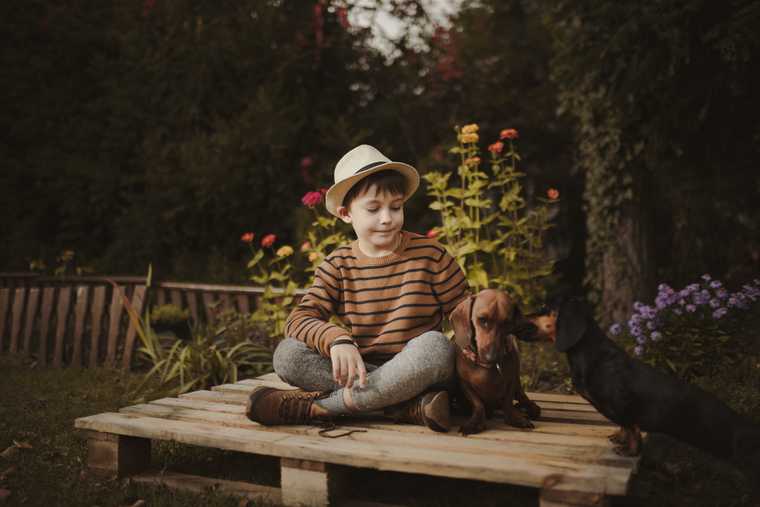
Choose the Right Dog
When searching for kid-friendly dogs, several factors should be considered. Size plays a crucial role, as tiny dogs may be more delicate and comfortable around older, cautious children, while larger breeds might thrive in a more energetic and rough-and-tumble environment.
Matching your family's lifestyle to the energy level of the dog is essential – whether you're seeking a playful companion for outdoor activities or a laid-back snuggle buddy. Additionally, considering the temperament of both your family and the prospective pet is crucial for a harmonious match.
Some dogs may love children, while others may find it difficult to tolerate them or just can’t channel their energy properly.
Below, you’ll find a list of dog breeds that mesh best with kids.
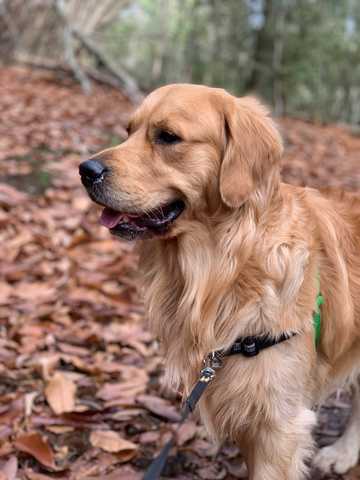
Golden Retriever
Goldens are the ideal family dog. These big goofballs are super laid-back and tend to take everything in their stride (including energetic children!). This breed is, in fact, often used in service work due to how biddable and calm they are.
It’s super important to choose a golden retriever that has been well-bred with temperament at the forefront of the breeder’s mind.
Labrador
Similar to the golden, it’s hard to go wrong with one of these classic family pets. Bear in mind that labs will have greater exercise needs than a golden, though!
Labradors love being around their family and thrive in a busy home environment. Labs are super trainable as well, so getting the kids involved with some basics should be nice and easy!
Bernese Mountain Dog
The Bernese isn’t a super common dog but one that gets undervalued as a versatile pet, in my opinion. These dogs don't have huge energy expenditure requirements and like a cuddle just as much as going out for a day of activities.
The Bernese tends to be pretty docile and tolerant around children.
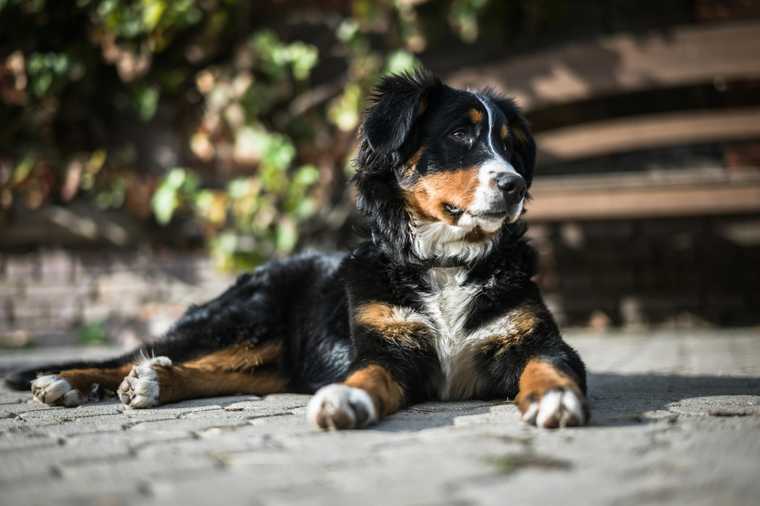
Bassett Hounds
Perhaps the most docile of all the hounds, the Basset makes an excellent, calm family pet. Some of them are very content to sleep all day, but do bear in mind they have a very loud bark/howl for their size!

King Charles Spaniel
Less energetic than the Cocker and Springer, Cavaliers tend to do really well in households with children.
They have a naturally sweet disposition and are eager to please both adults and children, making them a joy to train.
Prepare Your Kids
Decide responsibilities
From the very beginning, you need to decide who will care for the dog. Whether you're considering a canine companion as a gift for your child or just want a dog for yourself, it's important to recognize that all family members will share certain responsibilities, and these should be determined in advance.
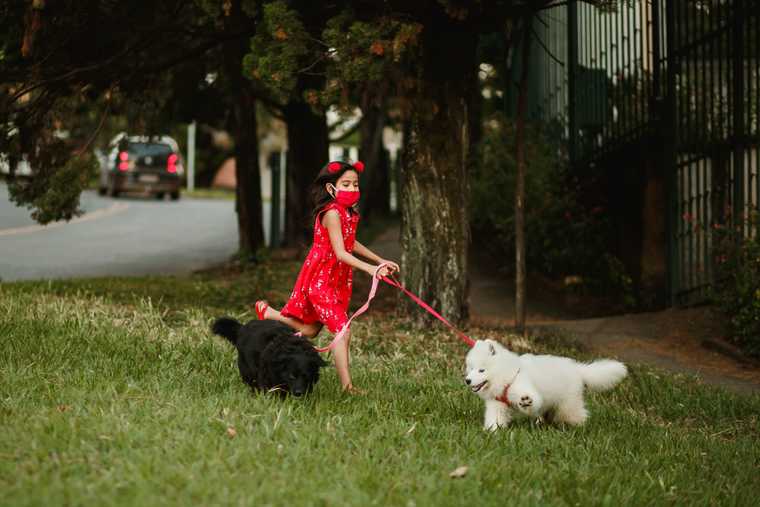
Educate your kids
Engage your child in a friendly conversation about dogs, covering the basics of their behavior, needs, and the significance of treating these wonderful creatures with kindness and respect.
Help your child understand that dogs, much like them, have emotions, setting the stage for a warm and informed introduction to a potential furry family member.
P.S. Visiting families with dogs and exploring books and movies about dogs will also be helpful here.
Manage Dog-Kid Interactions
Even if your child is absolutely in love with a new dog, you still need to make sure they know how to interact properly.
Here are some tips to help you navigate and foster a harmonious relationship between your canine companion and kids:
Set rules
Teach children the importance of gentle touch, advising against roughhousing to avoid discomfort for the dog. Establish clear boundaries, emphasizing respect for the dog's personal space during meals or rest.
Educate kids on recognizing warning signs, like growling* or attempts to move away, and encourage them to give the dog space when needed. Guide children in appropriate play, favoring the use of toys or playing fetch while discouraging behaviors like chasing or teasing that may make the dog anxious.
*If you see this behavior persist, it's highly recommended you consult a behaviorist.
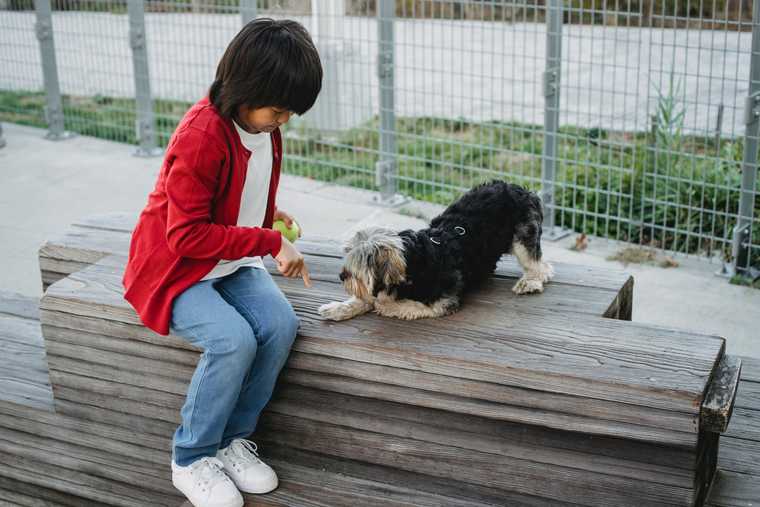
Train together
Basic obedience commands like "Sit," "Stay," and "Come" are beneficial for both dogs and children. Teach these commands to enhance communication and control in various situations.
Follow the step-by-step instructions provided in the Woofz app.
Socialize your dog
Expose your dog to interactions with children from an early age by creating positive experiences for both sides (e.g., reward when the dog lies down, appears calm, or follows commands around children).
This helps them become more comfortable and confident around kids.
Supervise your loved ones
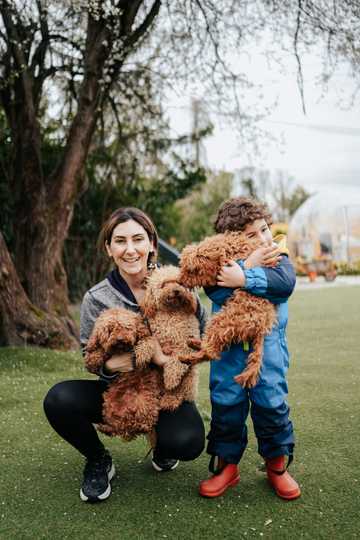
Even if your child appears to understand all the rules of playing and interacting with a dog, you shouldn’t leave them alone. If you can't supervise them, make sure to train your dog to stay in a safe place when you’re away (in a crate, a playpen, or a separate room) and instruct your child not to play with the dog until you return.
Cameras can assist you in monitoring both of them and preventing problems.
Involve children in dog care
If age-appropriate, involve children in simple dog care tasks like feeding or grooming. This fosters a sense of responsibility and strengthens the bond between the child and the dog.
But pay attention that your child doesn't do anything that can upset or hurt your pet.
Monitor food and toy sharing
Discourage children from sharing their food or toys with the dog, as some foods can be harmful, and toys may pose hazards or be easily destroyed.
Educate them about safe treats and snacks for canine friends, as well as safe dog toys.
Manage Dog-Toddler Interactions
If you have a toddler, it's crucial to closely monitor their interactions with the new dog and always be within arm's reach, ensuring gentle and supervised encounters.
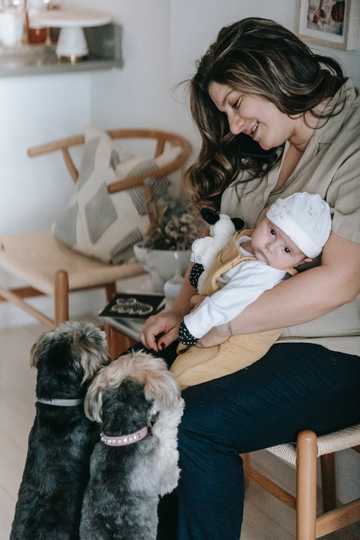
-
Teach your baby to steer clear of sudden movements or loud noises that might startle your dog. Encourage them to approach slowly and calmly.
-
Stress the importance of respecting the dog's space and help your toddler recognize when the dog signals that they need a break.
-
Educate your kid on the significance of being gentle during playtime, steering away from behaviors like pulling on ears or tails.
You can also teach your child a standing statue if the dog is getting too much (biting, jumping, or is over excited): tell them to stand up, cross their arms, and look at the sky. Then tell them to wait until mom says “Okay”, then carry on.
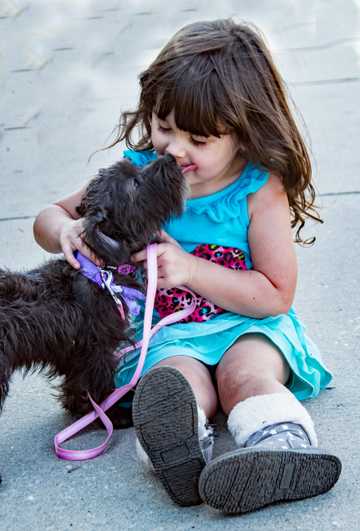
Wrap Up
When dog-kid interactions are done safely, it becomes a great journey for both parties. Dogs teach responsibility and empathy as children care for them, fostering routine and a sense of duty.
The friendship formed contributes to emotional well-being, providing a loyal companion and a source of joy. We hope this article helped you find the right approach, and we trust that both your dog and kids enjoy their time together.
Written by

Woofz Content Manager with a deep passion for dogs and a strong affinity for positive reinforcement training methods.
Reviewed by

Experienced dog trainer with Bachelor of Science Degree in Animal Behavior. Diplomaed dog nutritionist. CFBA Accredited Canine Behaviorist